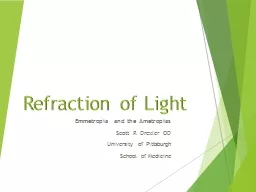

and the Ametropias Scott P Drexler OD University of Pittsburgh School of Medicine AKA Shape is Power Light is a Wave The direction and quality of that wave is changed as the wave transfers from one medium to another ID: 780548
Download The PPT/PDF document "Refraction of Light Emmetropia" is the property of its rightful owner. Permission is granted to download and print the materials on this web site for personal, non-commercial use only, and to display it on your personal computer provided you do not modify the materials and that you retain all copyright notices contained in the materials. By downloading content from our website, you accept the terms of this agreement.
Slide1
Refraction of Light
Emmetropia
and the
Ametropias
Scott P. Drexler OD
University of Pittsburgh
School of Medicine
Slide2AKA: Shape is Power
Slide3Light is a Wave
The direction and quality of that wave is changed as the wave transfers from one medium to another
Slide4Interface
The boundary between two media with different indices
n
n’
n
n’
n
n’
air
water
water
air
glass
glass
Slide5Snell’s Law
n
1
sin
q
1
= n
2
sin
q
2
n
1
= index of material before refraction
n
2
= index of material after refraction 1= incident angle
q 2= refracted angle
Slide6Snell’s Law
Light travelling from a less dense to a denser material will be refracted
TOWARDS
the normal.
Light travelling from a more dense to a less dense material will be refracted
AWAY
from the normal.
Slide7Snell’s Law
Slide8Index of Refraction
In a media other than a vacuum, light waves slow down and the wavelength also decreases
v=f
l
n=
Speed of light in a vacuum (C)
Speed of light in material
Note index of refraction varies with the frequency and wavelength of the light
Basically- How much light is bent by a material- the denser the material the greater the change
Slide9Index of Refraction
Since c is always the greatest(speed of light in a vacuum), n is always greater than 1.
It is convention to treat the
n
air
as 1.0
Vacuum =1
Air (
nonpolluted
) =1
Water= 1.33
PMMA =1.49
Crown glass =1.52 Diamond =2.417Cornea =1.376
Zeiss hi-index =1.8Crystalline lens= 1.42
Slide10Emmetropia
Slide11Ametropias
Refractive
problems, such as
nearsightedness, farsightedness, astigmatism, and presbyopia
are the result of an inability of the cornea and the lens to focus light on the retina. Instead, light is focused either in front of or behind the retina
.
Slide12Optical Correction
Two
basic types of lenses are
convex
and
concave
. A
convex
lens, also known as a
plus power lens, focuses light behind the lens; whereas, a concave
lens, also known as a minus power lens, focuses light in front of the lens. The power of a lens is measured in Diopters (D) and reflects the focusing distance in meters of the lens- a + 10 D lens focuses an image at 10 cm= 1m/10D
Slide13Concave lens- Minus power
Slide14Convex Lens-plus power
Slide15Myopia- Nearsighted
Slide16Myopia
Slide17Optical Correction
Slide18Myopia Progression- 42% of young adults in US are myopic
Slide19Myopia Control TreatmentsEyeglass
under correction
Peripheral plus eyeglass lensesBifocal Glasses
Bifocal Soft Contacts
Rigid Gas Permeable Contacts
OrthokeratologyAtropine
Outdoor exposure
Slide20Hyperopia- Farsightedness
Slide21Hyperopia
Slide22Optical Correction
Convex or converging lenses
Different treatment in adults and children
Frequently treatment based on symptoms
Slide23Astigmatism
Slide24Optical Correction
Toric
lenses- may be convex in one meridian and concave in another
Eyeglass lens or Contact lenses
Astigmatism has both magnitude and orientation so both glasses and contacts lenses must maintain the proper axis
+2.00 -1.50 X 060
Eyeglass lens is the better optical choice
Slide25Presbyopia- “I can’t read”
Loss of the accommodative ability of the lens that results in a difficulty focusing on near objects
Slide26Presbyopia Optical Corrections
Slide27Contact Lenses
Soft Contact lenses contain the actual power of the needed lens and drape over the cornea to correct vision
RGP contact lenses create a tear lens that functions to correct vision so that the resulting lens power may not be the same as the power of the eyeglass lens needed to correct the vision
Slide28Surgical Treatment
Slide29Surgical TreatmentHyperopic Lasik
Multifocal Lasik
IntacsLTK
Myopic Lasik is the most common and predictable of the group
Limitations of Lasik are corneal thickness and curvature
Refractive lensectomy
-
cataract removal
Slide30Lasik
Slide31Excimer
Laser
Slide32Scleral Contact lenses
Old technology made new again- from 1800’s
Bypasses irregular optics of the cornea by creating a new surface
Also used for eye surface diseases, cosmetic problems, and pain relief
Slide33Boston
KPro
Slide34Boston KPro
Slide35Thank You